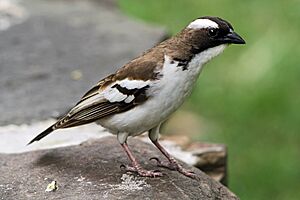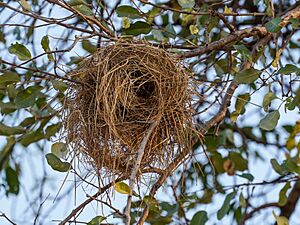White-browed sparrow-weaver facts for kids
Quick facts for kids White-browed sparrow-weaver |
|
|---|---|
 |
|
| Male, Baringo Lake, Kenya | |
| Conservation status | |
| Scientific classification |
The white-browed sparrow-weaver (Plocepasser mahali) is a small bird, about the size of a sparrow. It is mostly brown and lives in central and north-central southern Africa. These birds usually live in small groups of two to eleven. Each group has one pair that breeds and other birds that do not reproduce.
Contents
What is a White-browed Sparrow-Weaver?
This bird was first described in 1836 by a scientist named Andrew Smith. He found these birds during his trip to southern Africa in 1834–35. He gave it the scientific name Plocepasser mahali.
Where Does Its Name Come From?
Andrew Smith did not explain why he chose the name mahali. It is not a Latin word. It might come from the Setswana word mogale or the Sesotho word mohale. Both words mean a brave or fierce person. This suggests the bird's name might refer to its loud, scolding calls.
Different Kinds of Sparrow-Weavers
There are four main types, or subspecies, of the white-browed sparrow-weaver:
- P. m. melanorhynchus lives in eastern Africa.
- P. m. pectoralis is found from Botswana to Tanzania and western Mozambique.
- P. m. ansorgei lives in southern Angola and northern Namibia.
- P. m. mahali is found from southern Namibia to Zimbabwe and South Africa.
What Does It Look Like?
This bird is about 17 to 19 centimeters (about 7 inches) long. You can easily spot it by its wide, white stripe above its eye. When it flies, you can also see its white rump (the lower part of its back). Male white-browed sparrow-weavers have black beaks. Females have lighter, horn-colored beaks. Young birds have pinkish-brown beaks. In Zimbabwe, these birds have light brown spots on their white chests.
How Does It Sound?
The white-browed sparrow-weaver makes a short chik-chick sound. It can also make a loud, flowing whistle that sounds like cheoop-preeoo-chop.
How to Tell It Apart from Other Birds
The white-browed sparrow-weaver looks a bit like the yellow-throated petronia. However, the petronia has a pinkish-brown beak, not a black one. Its eyebrow stripe is buff (light yellowish-brown), not white. The petronia also has black feet, while the sparrow-weaver has pink feet. The petronia is smaller and has some yellow on its throat.
Where Does It Live?
You can find the white-browed sparrow-weaver in many parts of north-central southern Africa. They are most common in dry areas with woodlands or grassy woodlands in northern South Africa. Their home range also includes Botswana, Namibia, and western Zimbabwe. You can often see them in South Luangwa National Park in Zambia and southern Malawi. Some groups live as far north as Ethiopia. These birds usually stay in one place and do not migrate.
They build their nests in groups along thorny bushes and dry riverbanks.
Behavior and Life Cycle
Breeding and Nests
White-browed sparrow-weavers can breed all year, but they mostly do so in warmer months. Groups of these birds are always busy building nests. They make ten to sixty upside-down U-shaped nests from dry grass. These nests are built on the outer branches of trees. However, only a few of these nests are used for breeding or for sleeping.
Nests used for breeding have only one entrance. Nests used for sleeping have an entrance at both ends. Studies show that nests are often built on the side of a tree that is protected from the wind. This helps keep more nests safe for breeding and sleeping. Sometimes, other birds like the red-headed finch or ashy tit use the sparrow-weaver's nests.
How They Stay Cool
These birds can adjust their body temperature to stay cool in hot weather. Birds from very hot, dry desert areas let their bodies get warmer during the hottest part of the day. This means they do not need to use as much water to cool down. Birds from milder areas also change their body temperature, especially during the dry season. When it is very hot, white-browed sparrow-weavers spend less time looking for food in direct sunlight. Instead, they look for food in shady spots.
Status
The number of white-browed sparrow-weavers is growing. They are also spreading to new areas in the south, north, and east.
Gallery











